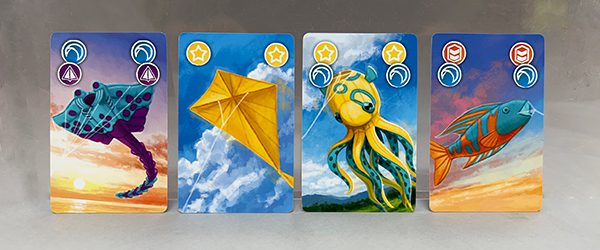“With tuppence for paper and strings
You can have your own set of wings
With your feet on the ground
You’re a bird in flight
With your fist holding tight
To the string of your kite”
– Let’s Go Fly a Kite by Richard Sherman and Robert Sherman
from the 1964 Walt Disney film Mary Poppins

Back in the early-to-mid ‘80s I was the night manager of The Kite Site in Georgetown, DC. It was a great job, working for a great guy (Hi, Chuck!) and with great people, (Hi, My Fellow KiteSiteers!) surrounded by kites and flying toys.
I came to that job knowing next to nothing about anything in the store. I left with both a considerable knowledge and collection of kites and boomerangs, as well as some really good friends. (All of which I still have to this day.)
When a game called Kites from Floodgate Games came up on our radar, I was skeptical. ‘How are you going to make a game about kites?’ I wondered. When I found out how, I jumped at the chance to give it a try.
Let’s Go Fly a Kite
Setup is about as easy as getting your kite aloft in a pleasant breeze.
Take all six of the differently colored sand timers and make sure the sand is at the bottom section of the timers. Then lay them down on their side within reach of everyone at the table.
Shuffle the deck of kite cards and, based on player count, deal out a number of cards to each player. Keep these face down for the moment.
Place the remaining cards within easy access of all players.
Choose a starting player. Then stand the white sand timer up as everyone picks up their cards.
And now you’re ready to start playing.
Up to the Highest Height
Kites is a cooperative game where players are working together to keep all their kites in the air. If a single kite falls to the ground, everyone loses.
Five of the six sand timers represent the kites, each a different color with a unique kite design on the top of the timers. The white sand timer is a special kite that you must kept aloft as well, but whose primary function comes into play at the end of the game.

On a turn, players will reveal a card from their hand in front of them. The first time you play a card matching a particular kite, that sand timer is stood up.

Depending on the card, the player will then either:
- Turn over the single sand timer that matches the single kite on the card.
- Or, instead, use the single kite card to turn over the White sand timer.(There are no white/Rainbow & Cloud cards.)
- Turn over the multiple sand timers matching the multiple kites on the card you just played.
And then draw another card from the deck..

As long as the sand timer still has sand running down, that kite is still in the air. If at any point, any of the six sand timers run out of sand, the game ends immediately.
To make things even more interesting, each sand timer has a different amount of sand. The red/Diamond kite, for instance, has a quick 30 seconds of sand; the orange/Box kite as 45 seconds; the yellow/Star kite and the white/Rainbow & Cloud have 60 seconds; the blue/Flexifoil has75 seconds; the purple/Delta kite has a leisurely 90 seconds.
Once all the cards have been drawn from the deck, the endgame gets triggered. Now, the white/Rainbow & Cloud timer can no longer be turned over. Players must run through all the cards in their hands before that (or any other) timer runs out.
And Send it Soaring
But wait—there’s more!
As if the six sand timers weren’t enough (and, trust me, they’re easily enough for your first several times playing Kites), the game includes three sets of ‘special’ cards that can be shuffled into the deck of kite cards:
- Storms: When you draw a Storm card, you say, “A storm is coming.” Then, on your next turn, you must play the Storm card. This forces ALL sand timers to immediately be turned over.
- Crossed-Lines: After drawing one of these, you say nothing. On your next turn, you must play the Crossed-Lines card. At that point, every player must trade one of the cards in their hand with a player to their right and left.
- Airplanes: As with a Crossed-Line card, after drawing this card you say nothing, but must play it on your next turn, stating, “Airplane.” The sound of the airplane overhead drowns out all sounds, meaning all players must remain silent until play comes to you again—unless, of course, someone else also plays an Airplane card, at which point the silence continues until the end of their next turn. This also means anyone who draws a Storm card cannot announce it’s been drawn.

Up Through the Atmosphere
In my review of Pendulum, another game that uses sand timers as a key mechanic, I wrote that there’s something about the falling sand that invites a state of flow to gameplay.
Put another way, sand timers force you to either stop thinking about the game and just play—or lose quickly.
If entering a state of flow could be bottled, I’d be screaming, “Take my money!” The times I’ve experienced flow, the concept of time has disappeared and my focus has been all-encompassing. Whether it was in writing, music, or gaming, it’s been great.
However, sand timers as a gaming mechanic, require you to be willing and able to give yourself over to the game. Otherwise, those running sands of time can induce stress.
I’ve played Kites with groups of two, four, and six. As a two-player game, the turns were fast and furious. We played five games in a row, caught up in the adrenaline, and feeling sure we could beat our last score. The four-player games were less successful. My admonitions of “Don’t think, just play!” were met with flustered reviews of the cards as sand ran out. We played seven games, most of which lasted only a few minutes because people just couldn’t get out of their heads enough to see the sand timers as game mechanics and not as threats.
The six player games were with BoardGameGeek Royalty W. Eric Martin and a group of playtesters. (Yes, this is conspicuous name-dropping. Turns out I live about 20 minutes from Eric and he frequently hosts Friday playtesting sessions at his house. And, yes, they’re as cool as you’d hope they’d be.)

With six gamers, Kites was a fantastic experience. Talk around the table focused on the timers that needed flipping; if someone said they didn’t have a color, someone around the circle said they did and play picked up to get to their turn. If someone only had cards with a color that had just recently been flipped, we’d take an all-too-brief breather to buy us some time with that color.
After the first game, there was no question we’d play it again. And again. We played until we won, then we played it again.
Up Where the Air is Clear
We’re halfway through the year and while it’s still a little early to be making judgments, I’m confident in saying Kites is going to be one of my favorite games of 2022. It might even be my Top Game of 2022. It’s sitting comfortably at the top of that list at the moment.
It’s a quick game that’s easy to teach and gets everyone involved faster than just about any other game I’ve played.
So what’s not to like?
Well, sand timer games are not for everyone. The others in that group of four I played Kites with? They were intrigued enough to keep playing…for a while. Between the Analysis Paralysis and the flustered stress, it was clearly a miss with them.
The other “not to like” thing with Kites brings me back to my old Kite Site Days.

Speaking of those old Kite Site days.
Despite not having built many kites on my own, I developed a good understanding of the physics behind how and why a kite flies. One of the key elements in proper kite design is the angle of the kite against the wind and how that angle is stabilized across the face of the kite. To do so, kites use some sort of bridling system, either through a piece of fabric sewn to the face of a kite (like the center keel of a Delta kite) or, more commonly, by attaching a series of strings with a fixed, central point. The apex of a bridle is where the kite string gets attached to the kite.
At the risk of sounding all “You kids get off my lawn!” old man cranky, some of the kites depicted on the cards in the game were just way off. Some of them could not fly as shown and one simply wasn’t a kite at all.

Don’t get me wrong: illustrator (and particular favorite of Meeple Mountain) Beth Sobel’s (Wingspan, Cascadia, Arboretum, Fjords, etc.) artwork is great. I only wish she’d done the proper research on her subject and not taken so much artistic license.
If you’re not a kite flier, would this bother you? No. Chances are you wouldn’t notice anything amiss on any of the cards. For me, however, I came close to losing my first game of Kites because I kept pointing out inaccuracies in the kites in front of me.
Is this being pedantic? When I mentioned this to everyone around the table on Eric Martin’s back porch, the feelings were mixed. Only Eric seemed to take it seriously, wondering how many other games lacked the same artistic editorial review before being released.
After Eric posted this question in his review of Kites on BoardGameGeek, someone from Floodgate reached out to me. Would I be willing to be their kite consultant for future editions of the game? (Of course!)
Rest assured, Kites made it to the top of my annual personal list of games before they offered me the consultancy position. Artistic flaws aside, Kites is a great family game, a great filler game, and a great vacation game. It packs a lot of game in a small box—a box just the right size for throwing in a backpack wherever you’re going, just in case there’s time to play a game.
Just be forewarned: make sure you have time to play several games because you’re not going to just play this one once.












Add Comment